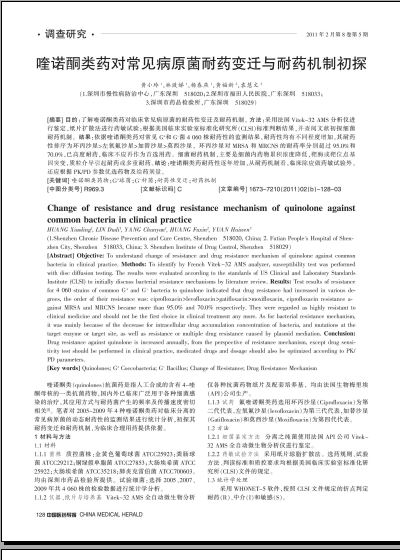喹诺酮类药对常见病原菌耐药变迁与耐药机制初探(1)
 |
| 第1页 |
参见附件(2762KB,3页)。
[摘要] 目的:了解喹诺酮类药对临床常见病原菌的耐药性变迁及耐药机制。方法:采用法国Vitek-32 AMS分析仪进行鉴定,纸片扩散法进行药敏试验;根据美国临床实验室标准化研究所(CLSI)标准判断结果,并查阅文献初探细菌耐药机制。结果:依据喹诺酮类药对常见G+和G-菌4 060株耐药性的监测结果,耐药性均有不同程度增加,其耐药性排序为环丙沙星>左氧氟沙星>加替沙星>莫西沙星,环丙沙星对MRSA和MRCNS的耐药率分别超过95.0%和70.0%,已高度耐药,临床不应再作为首选用药。细菌耐药机制,主要是细菌内药物累积浓度降低,靶酶或靶位点基因突变,质粒介导引起耐药或多重耐药。结论:喹诺酮类药耐药性逐年增加,从耐药机制看,临床除应做药敏试验外,还应根据PK/PD参数优选药物及给药剂量。
[关键词] 喹诺酮类药物 G+球菌 G-杆菌 耐药性变迁 耐药机制
[中图分类号] R969.3[文献标识码] C[文章编号] 1673-7210(2011)02(b)-128-03
Change of resistance and drug resistance mechanism of quinolone against common bacteria in clinical practice
HUANG Xiaoling1, LIN Dudi1, YANG Chunyan1, HUANG Fuxin2, YUAN Huiwen3
(1.Shenzhen Chronic Disease Prevention and Cure Centre, Shenzhen 518020, China; 2. Futian People's Hospital of Shenzhen City, Shenzhen 518033, China; 3. Shenzhen Institute of Drug Control, Shenzhen 518029)
[Abstract] Objective: To understand change of resistance and drug resistance mechanism of quinolone against common bacteria in clinical practice. Methods: To identify by French Vitek-32 AMS analyzer, susceptibility test was performed with disc diffusion testing. The results were evaluated according to the standards of US Clinical and Laboratory Standards Institute (CLSI) to initially discuss bacterial resistance mechanisms by literature review. Results: Test results of resistance for 4 060 strains of common G+ and G- bacteria to quinolone indicated that drug resistance had increased in various degrees, the order of their resistance was: ciprofloxacin>levofloxacin>gatifloxacin>moxifloxacin, ciprofloxacin resistance against MRSA and MRCNS became more than 95.0% and 70.0% respectively. They were regarded as highly resistant to clinical medicine and should not be the first choice in clinical treatment any more. As for bacterial resistance mechanism, it was mainly because of the decrease for intracellular drug accumulation concentration of bacteria, and mutations at the target enzyme or target site, as well as resistance or multiple drug resistance caused by plasmid mediation ......
您现在查看是摘要介绍页,详见PDF附件(2762KB,3页)。